Seasons > Easter > Decorations for the home > Living Room and Dining Room
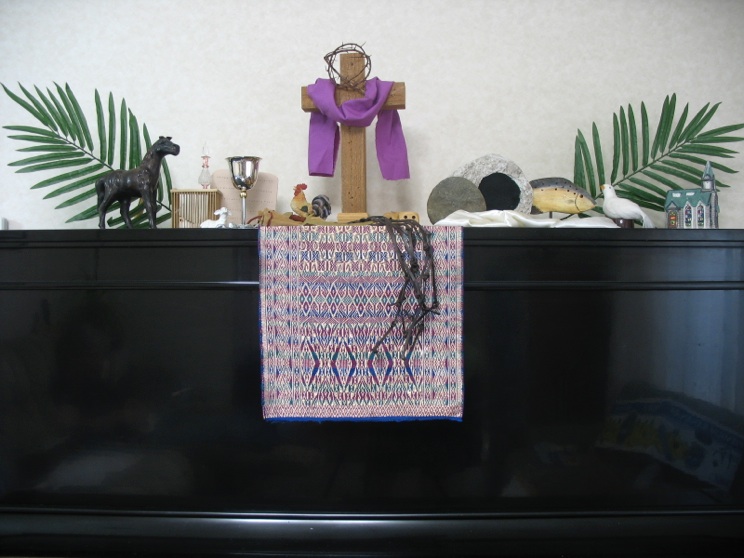
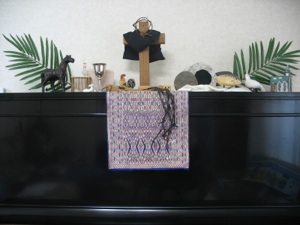

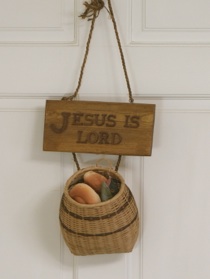



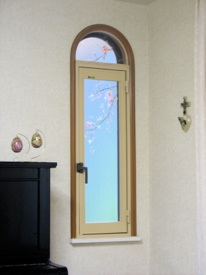
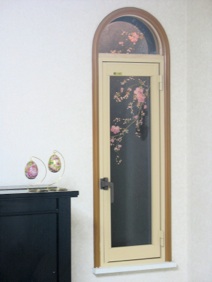



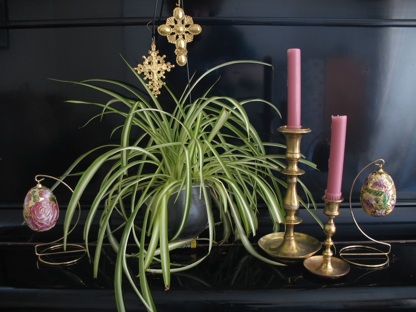
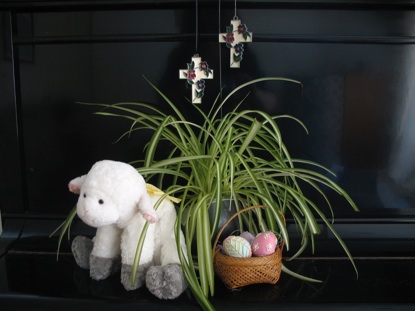
These items depict the final week of Jesus' life on earth. They are objects I used tell the Easter story in Sunday school on Easter morning, but then I realized that I could use them as Easter decorations all season instead of having them sit in a box until I used them on Easter morning. Now I display these Easter decorations for the 3 weeks leading up to Easter to represent the 3 days Jesus remained in the grave.
The purple cloth on the cross represents Jesus' royalty, and the robe that the solders put on him to mock him. This stays on the cross until Good Friday when it is changed to black to represent Jesus' death. Then Easter morning it is changed to white to represent his sinlessness and also the cloth that his body was wrapped in.
View objects closer, with description of what each object represents
These pictures show several options of how to decorate a welcome sign for Easter--from left to right, a basket holding a small vase of flowers, or grapes and bread representing the last supper, or a cross and flowers representing the new life we receive when we believe in Jesus’ work on the cross. The last version is not necessarily for Easter--it can be used any time. It reminds us of the time Jesus fed 5,000 people with a boy’s lunch of 5 loaves of bread and 2 fish--If he can do that for those people, he can do it for us as well. He is sufficient for all our needs.
view more detailed instructions for making a seasonal sign with Easter adaptions
This window seems to change colors at different times of the day. The bead flowers, purchased at a 100 yen store, glitter in the light during the day, and at night from the outside porch light. It’s fun to have flowers in a frosted window since there is no view. Decorated Easter eggs or candles can add more detail to this vignette.
Crosses are a good decoration for Easter because they represent Jesus work of salvation on the cross. They come in an amazing variety of designs, and inexpensive ones are fairly easy to find, even in Japan. They aren’t too hard to make, either. When decorating with crosses, they can be paired with flowers or candles or hung in groups of two or three. Another option it to collect a bunch, then hang them in alternate pains of a window, or hang several from a dowel, or frame them in a shadow box, or hang them individually in surprising places--over a light switch, on a door instead of a wreath, in the bathroom over the towel rack, etc.
Good places to find them--Christian book stores are a good place to start, but they are so expensive! In America, sometimes inexpensive ones are sold as Christmas tree decorations, and some American craft stores carry a pretty good selection of crosses-- Michael’s carries about 5 different styles , each, of unfinished wooden and resin crosses, (at least the one in Columbia, S.C. does.) Hobby Lobby carries a pretty large variety of finished crosses, and if you catch a sale, can buy them for a song. Occasionally I have found crosses at 100 yen stores--wooden ones in the garden section, ceramic ones with Halloween decorations, and quite a few in the necklace/keychain section.
The important thing to remember about cross decorations is that there is no magical power in them--they are not good luck charms that can be used for protection. They are simply reminders of the vast and amazing love that caused the creator of the universe to come to earth as a man and die in each person’s place so that no one who believes must suffer eternity in hell. What a wonderful event to celebrate!
Another easy way to add seasonal touches to your home is to group Easter items with potted plants that you have--the possibilities are only limited by your imagination. The two arrangements above are very similar, and show how you can use different objects to achieve a similar grouping. The one on the left is a little more playful with a stuffed sheep and basket of eggs, and the arrangement on the right is more elegant with brass candles sticks and gold crosses and decorated eggs hung from stands. All the crosses are hung from hooks poked into the dirt of the potted plants. You can quickly make these by cutting a length of wire from a coat hanger and bending one end into a loose loop. The gold crosses were inexpensive Christmas tree ornaments--just because that’s how they are sold doesn’t mean that is how they have to be used!

Seasons > Easter > Decorations for the home > Living Room and Dining Room
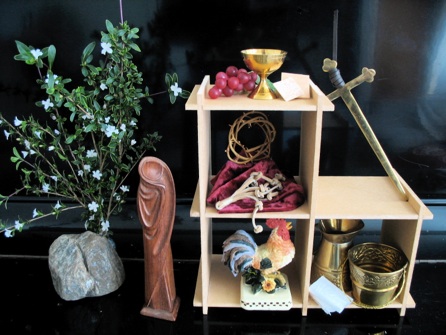

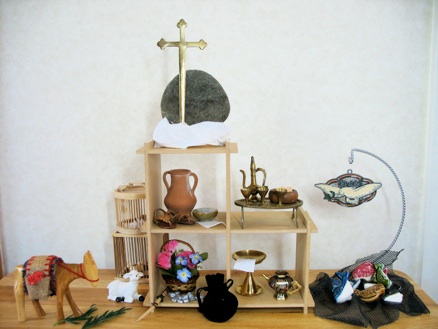
What would Christmas be without Easter--the culmination of Jesus’ saving work? Yet how many Christians celebrate Christmas for 4 weeks, and Easter for a mere one or two days? Let us resolve to celebrate it as if eternity depends on what happened on Easter!!!
These pictures show how you can make very similar displays using very different items. Once you have the stories of Jesus’ last week in mind, particularly keeping the objects in mind, you can find all kinds of inexpensive Easter decorations. This is especially good, since you are not likely to find the exact same items as I have. But don’t expect someone to put up a sign that says “Easter Decorations.” You have to keep your eyes open, and your mind open. For example, the brass cross on the left was a letter opener at a hundred yen store. You can use the same brass cross as a sword if you wrap the top portion with a strip of leather or plastic, as shown in the picture on the right, pointing to Gethsemane where Peter cut off the servant’s ear. In the picture on the left, the cages representing the cleansing of the temple, are actually bug cages purchased at a 100 yen store. The sheep was sold at Walmart as individual items for a Christmas nativity set. The fish, shown in the photo on the left, representing the time when the disciples went fishing and Jesus appeared to them, are ceramic chopstick rests sold at a hundred yen store. The wash basin for Pilot to wash his hands, also in the left photo, was a brass incense burner turned upside down. The brass goblet in the picture on the right was also a hundred yen incense burner with it’s lid removed. I can’t tell you where I got the tiny leather sandals, but if you ever find a pair, buy them to represent the foot washing during the last supper. The urn was about a dollar (100 yen) at a garden center, and I use it to represent preparations for the last supper when the disciples followed the man carrying water. The palm branches in front of the donkey are actually 100 yen bamboo leaves that have been cut to look like tiny palm branches, depicting the triumphal entry. Now that you have an idea of what to look for: Happy Hunting!



